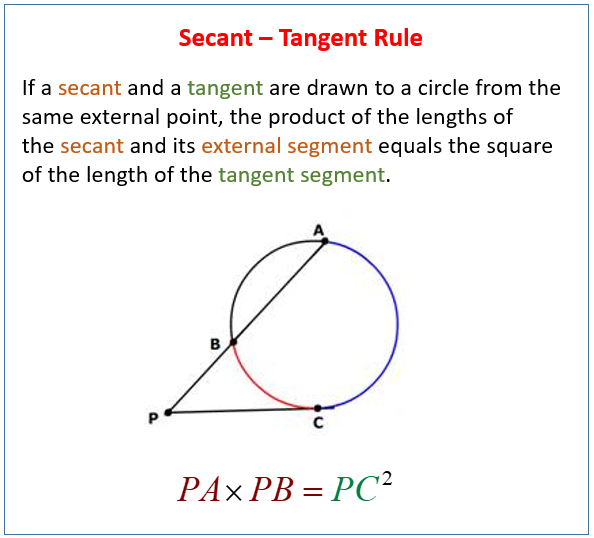Intersecting Tangent Secant Theorem
Related Topics:
More Lessons for High School Math Regents
Math Worksheets
High School Math based on the topics required for the Regents Exam conducted by NYSED.
The Secant-Tangent Theorem or Secant-Tangent Rule is a key concept in geometry that describes the relationship between tangent and secant line segments drawn from an external point to a circle.
What is the Secant-Tangent Rule?
If a secant segment and tangent segment are drawn to a circle from the same external point, the product of the length of the secant segment and its external part equals the square of the length of the tangent segment.
The following figures give the set operations and Venn Diagrams for complement, subset, intersect and union. Scroll down the page for more examples and solutions.

Statement of the Secant-Tangent Theorem
If a tangent and a secant are drawn from an external point to a circle, then:
(Length of tangent)2 = (Length of secant) × (Length of external segment of secant).
Mathematically, if:
PT is the length of the tangent,
PA is the length of the secant from the external point to the first intersection with the circle,
PB is the length of the secant from the external point to the second intersection with the circle,
then:
PT2 = PA × PB.
Segments of Secants and Tangents Theorem
The segments of a secant segment and a tangent segment which share an endpoint outside of the circle. The product of the lengths of the secant segment and its external segment equals the square of the length of the tangent segment.
Power of a point with a tangent segment and a secant segment
Tangent - secant demonstration
Demonstration of a circle geometry property
Tangent Secant Theorem (with quadratic expressions) - Geometry
This video focuses on using the Tangent Secant Theorem to find the length of a tangent line segment. This video also reviews how to find the roots of a quadratic equation.
Try out our new and fun Fraction Concoction Game.
Add and subtract fractions to make exciting fraction concoctions following a recipe. There are four levels of difficulty: Easy, medium, hard and insane. Practice the basics of fraction addition and subtraction or challenge yourself with the insane level.

We welcome your feedback, comments and questions about this site or page. Please submit your feedback or enquiries via our Feedback page.